This Travel Journal submitted by AdventureSmith traveler Maria R. details her Hawaiian Seascapes cruise aboard the Safari Explorer. Learn more about Hawaiian Island cruises.
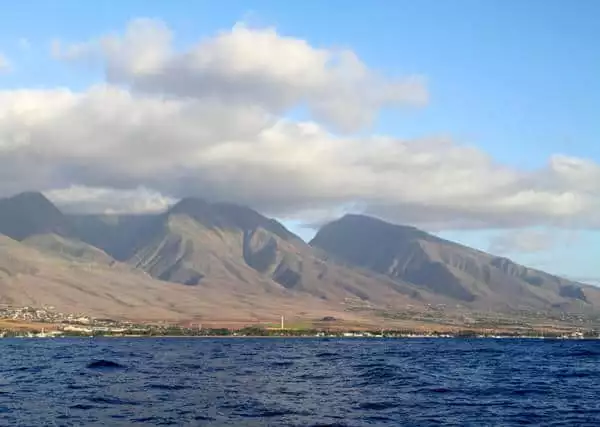
Day 1 – Embarking the Safari Explorer
We wake up early and set off for the Hapuna Beach Prince Hotel and Golf Course, where we will be collected by the cruise company and taken to the Safari Explorer, our home for the next week. We have spent one night on “The Big Island” which is very beautiful, but I am excited to join the cruise and to discover the rest of the Hawaiian islands!
The drive from Waikoloa Beach Resort to Hapuna Beach is around 15 minutes and takes us along Queen Ka’ahumanu Highway – a long, straight road over the black volcanic rocks and dry terrain.
We have just boarded the minibus when I hear our guide saying “look over there at the wild turkeys in the hotel”. I think that he is joking but sneak a peek anyway only to see two wild turkeys casually wandering past the entrance. I grab my camera and jump off the bus to snap a few photos of them before we leave.
Wild turkeys were the first bird species to be introduced to post-contact Hawaii when ‘a number’ of domesticated birds were brought to Hawai’i Island from China in 1788. By 1789 they had bred 20 young and by 1825 they were abundant on Oahu. Continued introductions from 1815 to 1963, including 400 wild Texas turkeys, along with escaped domestic stock have resulted in established wild populations throughout the islands.
We arrive on the Safari Explorer and are shown to our cabins. The flagship is a 36-guest, 145 foot yacht that is ‘perfectly designed for luxury in the pursuit of adventure.’ After the standard safety briefing we head onto the deck to watch the beautiful Hawaiian sunset as we set sail.

Day 2: Skurfing, Kayaking & Manta Rays
After breakfast we gather on the aft deck for the first of the week’s activities – skurfing behind the skiffs. Skurfing is a water sport that consists of a person being pulled along by a motorboat with a ski rope while standing on a small surfboard.
Our activities manager, Brock, shows us how to set off and then we are invited to give it a go. I sit on the edge of the deck with my feet on the skurfboard and hold onto the ski handle. The skiff takes off and I slowly rise up on the board. I wobble a little and I think that I may end up in the water but years of water-skiing serve me well and I am able to stay upright. We lap the boat twice before I let go of the handle and slowly sink into the waters of the Pacific Ocean. It is a wonderfully exhilarating experience.
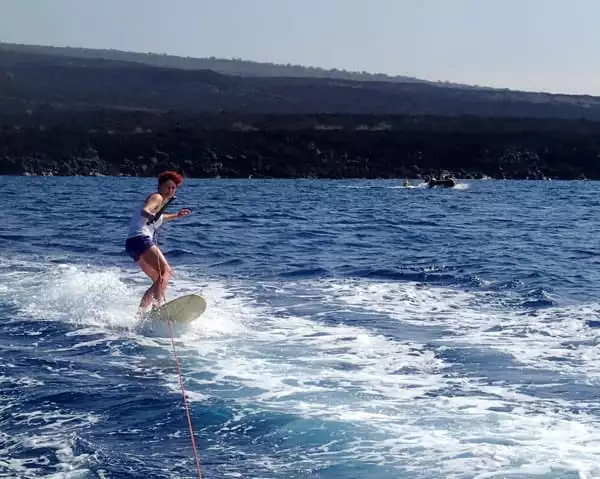
We spend a while playing with the skurfboard and then the crew lower some kayaks into the water. A group of us set off in the kayaks and paddle along the volcanic shoreline until it is time for lunch.
As the sun begins to set I am getting very excited about the next activity which will take place once we have anchored off the shore of Kailua-Kona and the sun has gone down. Once again we gather on the aft deck and this time we are given wetsuits, masks and snorkels – we are about to set off on the skiffs for a night snorkel to look for giant pacific manta rays.
Manta rays are the largest rays; they can be up to nine metres wide and can weigh over 1,000 kilograms. They are the largest species of flattened fish and are closely related to other cartilaginous fish such as sharks, although they are harmless and have no stinging spine. They do not even have teeth and they eat by sieving food particles out of the water using rows of tiny plates in their mouths. They are very graceful swimmers and acrobatic animals – they can even leap right out of the water.
Manta rays have been Kona’s most unique attraction to travelers since they were ‘discovered’ in the early ´90s. The waters near the shores of Kona are home to one of the most robust and accessible populations of manta rays in the world. While these animals are found in most oceans of the world, their regular appearances to feed at night in Kona make this a very unique spot.
We take our seats in the skiffs and head off into the darkness. Soon we arrive at the ‘campfire’, an area that has been set up with powerful underwater lights that will attract plankton and, in turn, attract the mantas that will come to feed. We are each given a marker light wristband and instructed to hold onto the floatation device that is tossed into the water so that we do not float away from the group. There are many other boats and groups of people at the campfire and, as it is very dark, is it difficult to tell who is who. We slip into the water and swim over to the centre of the campfire.
We have only been in the water for a few seconds when I see the first manta ray.
We have only been in the water for a few seconds when I see the first manta ray. We have been told that they are harmless but not to touch them, as their skin is covered with a mucus that protects them from infection and by touching them we could remove this mucus and cause them to become vulnerable.

The experience is incredible and indescribable – there are countless mantas and other fish and they are everywhere. They do a sort of barrel roll in order to feed on the plankton that we have attracted with the lights and brush up against us as they do. These beautiful, graceful creatures are huge and each have distinguishable features. Later our guides are able to name quite a few of the mantas, identifying them by the marks on their bellies.
When we return to the boat myself and the other guests try to describe the experience to those who did not go – “it was amazing” is about the best that we can come up with as no words will give justice to what we have just experienced.
Day 3: Hawaiian History & Bottlenose Dolphins
Today we are collected by Captain Zodiac, Kona’s ‘most experienced rafting company’.
Once we are all aboard the zodiacs we set off along the Kona coast where we enjoy the beautiful, rocky coastline. Along the way our captain points out various interesting features, such as the blowholes and caves.
We continue along the shore until we reach Kealakekua Bay. The bay is located about 20 kilometres south of Kailua Village and is a Marine Life Conservation District. It is also a very important historical location as it marks the site where Captain James Cook landed on the Hawaiian islands. Cook was the first British explorer to establish contact with the Hawaiian islands, in 1778. Just one year later he was killed in a skirmish with Hawaiian natives right here in this bay. The Captain Cook Monument on the shore commemorates his death and on the eastern side of the bay there is a small temple that is dedicated to the Hawaiian god, Lono.
The waters at this bay are crystal clear and filled with coral and schools of tropical fish. This area supposedly offers some of the best snorkeling on the island and I am eager to get in the water. I see some longnose butterfly fish, raccoon butterfly fish, brassy chubs, barred filefish, yellow tangs, sea urchins, starfish and plenty of coral. The marine life in this area really is thriving.
After almost an hour in the water, snapping photographs of all the weird and wonderful fish and crustaceans that I see, I return to the zodiac where there are drinks and snacks waiting for us. I relax in the sun until the rest of the passengers have returned and then we set off back along the coast.
The captain has been pointing out some interesting features but he has now gone quiet. We pull away from the island and then he turns the zodiac back towards the rocky shoreline and cuts the engine. He points at the cliffs in front of us and asks what we see. We all stare at the rocks unable to agree on what they could resemble. The captain’s assistant has moved to the front of the zodiac and is now lying on her side. We barely notice her to start with, as we are all so busy trying to see some shape in the cliffs. After a few minutes we realize that she is giving us a hint and suddenly it becomes so obvious. The cliffs have a real likeness to a woman lying on her side with long, wild hair and slightly scary looking eyes. She is Pele, the goddess of fire!
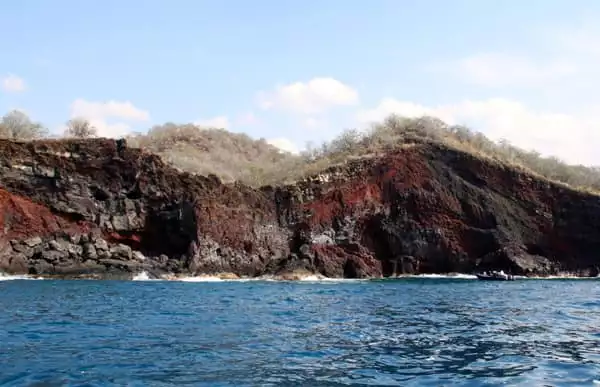
‘She-Who-Shapes-The-Sacred-Land’ was passionate, volatile and capricious. She throws molten fountains into the air, governs the flow of lava and has been known to show herself throughout the island.
As we continue on our way back to the Safari Explorer our captain points out a long, straight path down the side of the hill. It looks to me to be some sort of firebreak but the real story is much more exciting. This is a he’e holua track – he’e holua was a sport that was practiced by the Ai’i, the Hawaiian ruling class. This ancient sport is a sort of lava sledding – the competitors would slide down a slope of lava rock on a sled made out of wood and palm fronds.
We then pass St. Peter’s Catholic Church that was built in 1889 on the site of an ancient Hawaiian heiau (temple) and has no more than 12 pews. Also known as ‘the little blue church’, it is located right on the shore and was made of clapboard with a corrugated tin roof. It is now a very popular wedding venue.
A pod of bottlenose dolphins join our zodiac as we continue on our way. The playful dolphins ride the bow waves of the zodiacs until we are almost back at the Safari Explorer.
The playful dolphins ride the bow waves of the zodiacs until we are almost back at the Safari Explorer.
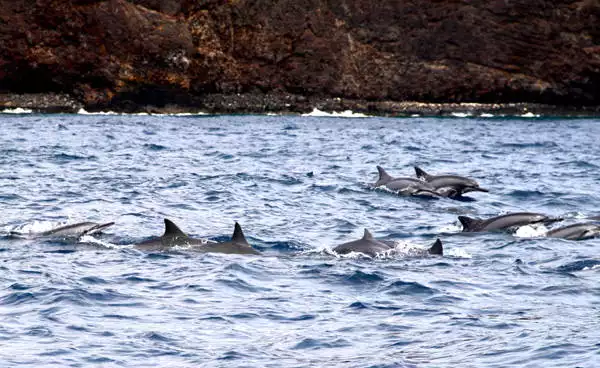
After a lovely lunch on board it is time to head ashore to visit Kamakahonu Bay. The name Kamakahonu comes from the Hawaiian words for ‘the turtle eye’ and it is believed that it originated from a rock shaped like a turtle that is now located under Kailua pier.
As our skiffs come in to the beach some children are splashing about in the water and a few families are playing football on the sand. The locals have nicknamed the beach ‘children’s beach’ as it is one of the safest for swimming in Kona due to its shallow water and gentle waves.
Our first stop is the temple of King Kamehameha the Great. It was the king’s personal refuge and his home for the last few years of his life. The temple, Ahuena Heiau, was built by King Kamehameha I, when he returned to the big island in 1812, to honour Lono, the God of fertility. The king died in this temple in 1819 and his remains were taken to a secret burial place. The temple is now highly respected and no-one is allowed inside or on the grounds surrounding it.
When King Kamehameha I died his son, King Kamehameha II, broke the ancient Kapu system, ‘a highly defined regime of taboos that provided the framework of the traditional Hawaiian government. During this time the people’s spirituality declined and the temple’s sanctity came an end. Decades later the temple underwent some restoration but it was not until 150 years later that a community based committee, Ahu’ena Heiau Inc., formed and an accurate restoration project was undertaken.
In the 2011 tsunami some parts of the temple were damaged including Anu’u Tower, where the chief kahuna would go deep into trance and receive messages from the gods.
As we arrive at the temple we see several tall ki’i akua (statues of god). The tallest statue has a wooden bird standing on its head. This bird is the golden plover, which was said to have lead the ancient Polynesians to Hawaii.
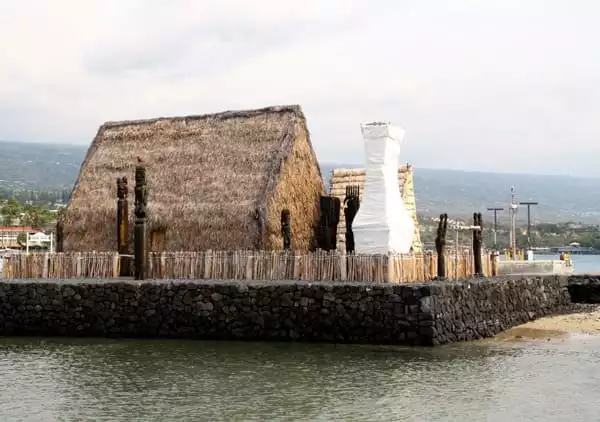
After admiring the temple we make our way inside the lobby of the Marriott’s Courtyard King Kamehameha’s Kona Beach Hotel, where there is an exhibit on the history of the area and its inhabitants. We spend a while looking at the fantastic paintings and reading about the history of the island, the temple and the life of King Kamehameha.
We leave the hotel and walk to Mokuaikaua, Hawaii’s first Christian Church. The origin of the church’s name is somewhat unclear. The literal translations have been said to mean ‘the trees are cut, let us eat’ and ‘the land that devours warfare’. It is believed that the name is actually due to the place where the timber material was obtained – it was part of the crown properties known as Mokuaikaua, located on the western slopes of Mount Hualalai.
The first missionaries, sent by the American Board of Commissioners for Foreign Missions, arrived in Hawaii in 1819. They soon learned that King Kamehameha I was dead and that the kapu had been broken, meaning that the old religion was in turmoil. It was agreed that the missionaries could stay in Hawaii with certain conditions on where they could stay. One of the ministers (along with a physician) was assigned to stay in Kailua. This established the groundwork for the building of the church and the original building was completed in 1820.
We have just over an hour to wander around the area and to do some souvenir shopping before the skiffs will be coming back to pick us up. After a while we head to Kaulue Pier where the skiff will collect us. Tonight we will set off for Lanai, where we will spend Christmas day.
Day 4 – More History, A Pineapple Plantation & Snorkeling
Overnight we have traveled to Lana’i, which is known as Hawaii’s most enticing island. Although it is the sixth largest of the Hawaiian islands it is actually the smallest inhabited island within the archipelago, covering around 160 square kilometres. Only nine miles away from the island of Maui, the island has around 3,000 inhabitants and is a place of deep cultural significance.
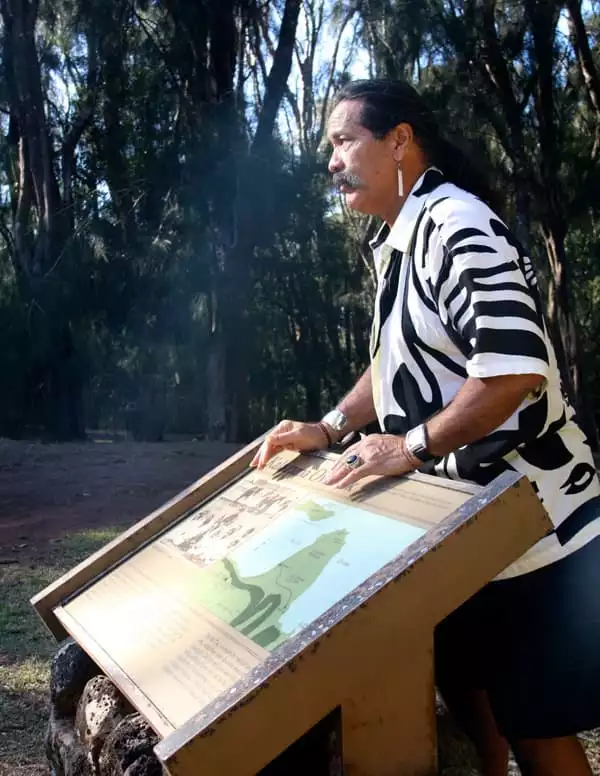
In ancient times it was believed that Lana’i was dominated by evil spirits. Natives were afraid to visit the island and therefore not much is known about its early history. Legend has it that the King of Maui banished his nephew, Kaululaau, to the island as punishment for his constant disobedience. He was to explore the island and, if he survived, he was to make a fire that would be visible to the people of Lahaina (then called Lele). Much time passed and hope for Kaululaau, the son of the high chief of Lele, faded until one night a fire pierced the darkness. It was believed that Kaululaau had overcome the dark spirits and had made Lana’i safe for settlement.
Our first stop on the island is Pu’u Pehe, also known as Sweetheart Rock, which is one of Lana’€’s most recognisable landmarks.
The story is of a beautiful Hawaiian maiden from Lahaina called Pehe and a young warrior from Lana’i called Makakehau. The young warrior was so taken by Pehe’s beauty that he would well up every time he set eyes on her. He gained his name from the Hawaiian words of ‘maka’, meaning eyes, and ‘kehau’ meaning mist. He took Pehe toLana’i as his wife and hid her in a sea cave at the base of Manele’s cliffs so that no other men could see her. One day Makakehau was out gathering supplies when the weather drastically changed and the raging surf began to pound on the side of the island. He rushed back to the cave but, alas, it was too late and Pehe had drowned by the surge of storm waves. Stricken with grief Makakehau gathered her in his arms and, with the help of the gods, he climbed the steep rock island. He buried Pele in a tomb and then jumped off the 25 metre tall rock to his death.
We follow the trail from the Hulupo’e Beach, up the side of the cliff, to the overlook of Pu’u Pehe rock. From here we are able to see the “tomb” on the top of the triangular-shaped rock. Archeologists state that there are actually no human remains in the ‘tomb’ and suggest that it may in fact have been bird heiau (temple) built by ancient Hawaiians. Whatever the real history of the rock is the view is incredibly beautiful.
The Lana’i Culture and Heritage Centre is a non-profit charitable community organisation that seeks to inspire people to be informed about Lana’i’s natural history by preserving, interpreting and celebrating it. The slogan of the centre is E Hoohanohano ana i ka wa ma mua, a e Hoolako ana i ka mua akuâ, which means Honoring the Past and Enriching the Future. We head inside and wander through the museum looking at the various historical collections and photographs and, as we do, we learn about the history of the island.
In 1862 there was a population of around 600 living on Lana’i. A missionary named Walter Murray Gibson arrived on the island with other followers of the Mormon church to establish a colony. Three years after his arrival the self-trained botanist was excommunicated for allegedly misusing church funds and he turned his focus to ranching. He consolidated 26,000 acres of land to form the Lana’i Sheep Ranch in the area of Keole. During his time on the ranch Munroe noticed that a Norfolk pine dripped water onto the roof of the ranch house and realized that these trees collected water from the fog and clouds. Following this discovery he planted pine trees across the island to restore its watershed and improve the ground-water supply. These trees are now the island’s landmarks and are visible from Maui.
In 1899 James Drummond Dole arrived in Hawaii. He had recently gained his degree in Business and Agriculture at the University of Harvard and was eager to prove that Hawaii could take part in the ‘boom times for farming that were sweeping across America’. He bought 61 acres of land in Wahiawa, Oahu and established the first pineapple plantation. Although he was not the first person to grow pineapples in Hawaii, he was the first to realize their tremendous potential and he soon became known across America as the Pineapple King. As the demand for pineapples grew so did the need for more land and Dole purchased Lana’i in 1922. He transformed the island into the largest pineapple plantation in the world, with 20,000 farmed acres and a planned plantation village to house over 1,000 workers and their families. For nearly 70 years Lana’i supplied more than 75% of the world’s pineapples and became widely known as ‘Pineapple Isle’.
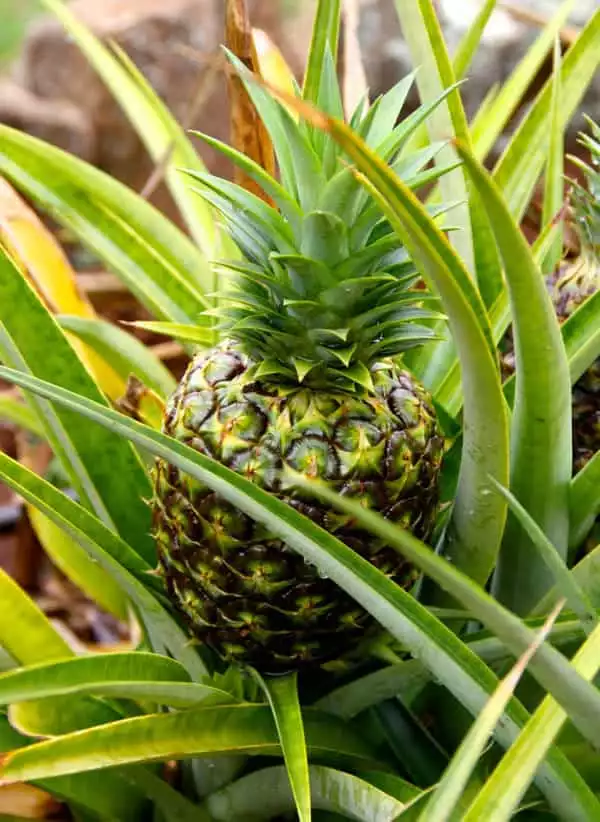
When we leave the Culture and Heritage Centre we travel north, towards Kaiolohia Bay. We travel along the winding Komuku Road that leads from Lana’€™i City to the shore. The minibus pulls over and our driver invites us to take some photographs from the viewpoint – from here we can see the islands of Moloka’i and Maui. Just off the shore is the shipwreck that gave Kaiolohia Beach its common name of Shipwreck Beach. Shipwreck Beach is known for its shallow reefs and strong currents – it has wrecked many ships and one shipwreck is still visible today. We enjoy the view and take plenty of photographs before continuing on our minibus tour of the island.
We travel back along the road we have come down and head into the city of Lana’i. The city is located in the central highlands at an elevation of just over 500 metres. Despite its name of Lana’i City it is not what most people would call a city at all and has a population of just over 3,000. We drive past small wooden houses and roads are much more similar to country roads than to the roads in most cities. We see two deer sitting behind a fence in what appears to be someone’s back garden. Lana’i has a wonderfully old fashioned and quaint feeling to it.
We arrive at Kaumalapau Harbor where the skiffs will collect us and take us back to the Safari Explorer. While we wait for the skiffs to arrive I wander a little way along the rocks of the breakwater and photograph some of the dozens of crabs that are hiding in the rock-pools. Soon the skiffs arrive and we clamber aboard. We are on our way back when the skiff driver spots a pod of bottlenose dolphins playing nearby. We take a detour and find ourselves in the middle of countless dolphins, leaping out of the water and swimming past us in perfect synchronisation.
I am doing my usual, snapping photographs of the sky and the sea as I try to photograph the dolphins and then suddenly a dolphin leaps vertically out of the water just where I am pointing my camera. With the perfect shot in hand, albeit more good luck than guidance, we head back for some lunch before the afternoon’s activities.
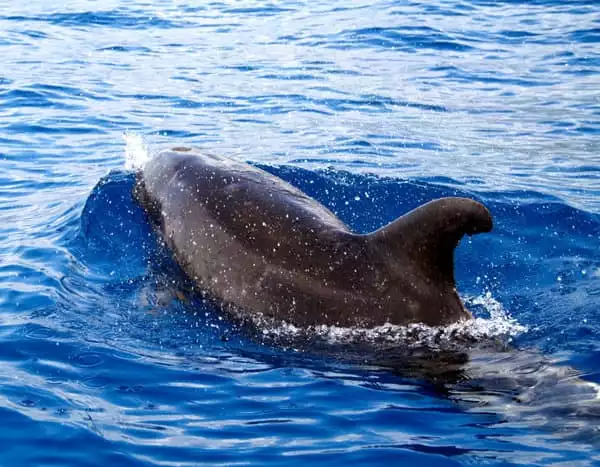
During lunch the Safari Explorer is on the move and as we finish dessert we arrive at Lana’i Shark Fin Cove. This area is said to be one of the best areas for snorkeling and diving in Hawaii. The site is named after a small rock that breaks the surface of the water, resembling a shark’s fin.
As the crew lower the paddleboards and kayaks into the water, I grab my mask, snorkel and flippers and join the group who are heading out to snorkel. We pass shoals of butterfly fish, clown fish and parrot fish. After a while I swim back to the Safari Explorer and decide that it is time to have a go at stand-up paddle boarding. One of the crew, Patience, says that she will teach me how and we grab two paddles before climbing onto the boards. The idea of paddle boarding comes from the way fishermen all over the world would stand in their small boats and paddle across the water. It is believed to have been the Hawaiians who pioneered stand-up paddling for fun and so this feels like the perfect place to be learning the increasingly popular sport.
Patience and I head out and she shows me how to start off by kneeling and then to slowly stand up, keeping my balance. It is a wonderful feeling to be paddling across the water below the majestic cliffs. We pass the group of snorkelers and the ‘shark’s fin’ and make our way along the rocks to the end of the cove. The sea is choppy today, making the surroundings look even more dramatic and the name “Shark’s Fin Cove” even more fitting. I have been doing well so far but I get a little over confident as a small wave approaches and end up in the water – luckily I manage to climb back on without much trouble. When we return we take a swim to cool off (it turns out that paddle boarding can be quite exhausting!) and float in the warm water at the base of the world’s second tallest sea cliffs.
It is incredible to think that only a few days ago these people were complete strangers and yet now it feels as though we have known each other forever.
After a shower it is time for Christmas dinner and I join a table with two couples in the dining room. We chat about the cruise, the activities that we have been doing and the excursions that we have coming up over the next few days. It is incredible to think that only a few days ago these people were complete strangers and yet now it feels as though we have known each other forever.
Day 5 – Paddleboarding, Lahaina & Surfing
On day five of our Hawaiian island cruise we wake up off the coast of Olowalu, Maui. Olowalu is approximately six and a half kilometres south of Lahaina and Olowalu reef, known as the ‘Crown Jewel’ of Maui’s reefs, is home to one of Hawaii’s most unique reef systems. The reef is Maui’s biggest and it features an abundance of marine life and at least 24 different species of rare coral, some dating back 500 years, spreading across 450 acres.
After breakfast the crew prepare the kayaks, paddle boards and snorkeling equipment. I decide to paddle board and set off with three others and one of the crew members who will be our guide. We paddle towards the shore and find ourselves gliding over the crystal-clear shallow waters and the beautiful reef below. The water is only around one metre deep in most places and from time to time we paddle around parts of the reef that break through the surface of the water. The scenery is truly breathtaking.
We are the only people in sight and all I can hear is the sound of our paddles splashing in the water as we travel over the reef. We spot turtles swimming below us, starfish, sea urchins, tropical fish and all kinds of beautiful and colorful corals. After a while I decide that it is time to take a closer look at the marine life below me and head back to the Safari Explorer to get my mask, snorkel and flippers.
I dive into the water and swim over to the group that is snorkeling. When I arrive one of the guides, Brock, signals for me to follow him and we dive down to the ocean bed. He points and I see a Hawaiian Green Sea Turtle resting on the sand, I swim closer and take some photographs. I am careful not to get too close in case I scare the turtle but it hardly seems to notice us. When we head back to the surface for air Brock explains that this is a turtle cleaning station. Cleaning stations are areas where turtles congregate to get their shells cleaned by algae-eating fish and to have their skin picked clean of parasites. I dive back down again and find more turtles resting on the ocean bed, waiting to have their shells and skin cleaned.
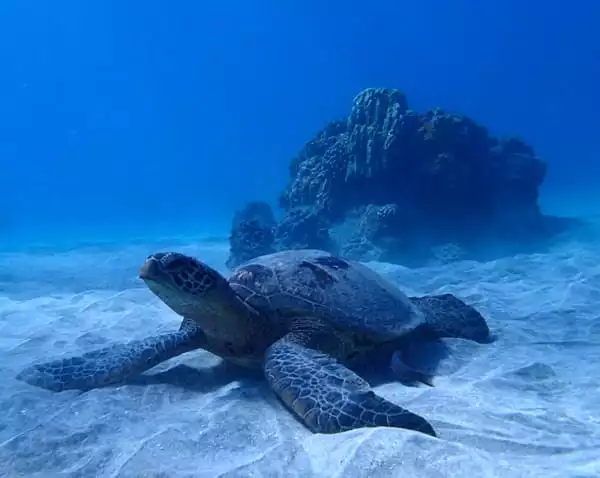
A needlefish swims past and then I spot a bluespotted grouper, a sergeant major, and a Hawaiian black triggerfish. A shoal of yellowtail snappers pass us by and on the reef I find many more weird and wonderful species that I have never even seen before.
It is almost lunch time already and I can hear the guides calling us to return to the Safari Explorer. The skiff drivers are getting ready to return and are tying on the paddleboards in order to tow them back. There is one paddleboard left over and the skiff driver, Mike, asks if I would like to surf back on the board by holding onto a rope from the skiff. I jump at the opportunity!
Ours is the only boat in sight and there is no-one else around. I feel truly privileged to be in such a beautiful place!
I climb onto the paddleboard and grab the rope. We take off and slowly I stand up. I look back at the beautiful shoreline of Olowalu, the crystal blue waters, the clear sky and the horizon. Ours is the only boat in sight and there is no-one else around. I feel truly privileged to be in such a beautiful place!
I am about to get changed for lunch when I hear one of my fellow passengers asking if they can jump off the second deck. I turn back to see what the answer is and a few minutes later we are leaping off the second deck and splashing into the ocean. Even the captain has a go!
During lunch we are underway and we travel to Lahaina, a historic whaling village that has now become a Maui ‘hot spot’. The town was once known as ‘Lele’, meaning ‘relentless sun’ and was the capital of the Hawaiian Kingdom in the early nineteenth century.
It is time to visit Hui O Wa’a Kaulua (The Assembly of the Double Hull Canoe in Hawaiian), Maui’s Voyaging Society. The society is a non-profit organization that was formed in 1975 to practice, perpetuate and educate the community on Hawaiian canoe building, wayfinding and voyaging arts.
We pass Mo’olele, meaning ‘leaping lizard’, a 42 foot Hawaiian double hull sailing canoe that was built in 1975. This canoe has sailed the Hawaiian islands and served as a floating classroom for several decades. A volunteer comes out to greet us and tells us about the history of the society and of Mo’olele.
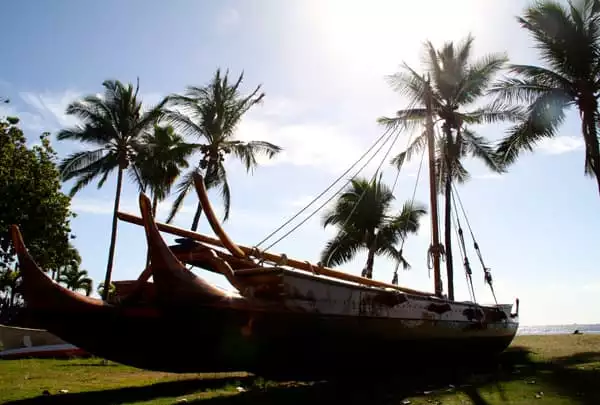
We follow the lady into a large, shed-like building where Mo’okiha o Pi’ilani, meaning ‘The Sacred Lizard of Maui’, is kept. This 62 foot, double-hulled voyaging canoe is still waiting to touch the water for the first time and when she does she will serve as a living classroom for the youth of Hawaii and the community of Maui. We are invited aboard and climb up a ladder, onto the deck. We are told about the voyages that are planned for her as we make our way across the deck, learning about how she will be sailed, where the crew will sleep and how they will navigate in the traditional way. She is beautifully handcrafted and it sounds as though she has plenty of exciting adventures ahead of her.
We wander along the main street of Lahaina, which is lined with shops and restaurants. There are also over 40 fine art galleries in Lahaina, many of which also have branches in cosmopolitan locations across the world.
My attention is drawn to a small red bird that is eating some crumbs on the ground. It turns out to be an extremely photogenic red-crested cardinal. As usual, my photo-taking makes me late and when I get to the pier the last skiff is waiting for me.
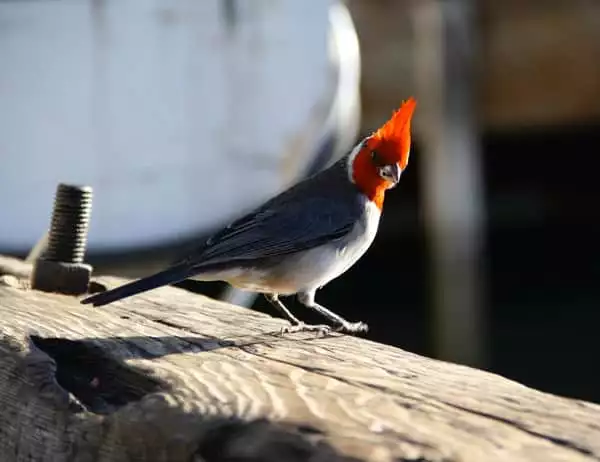
Suddenly the skiff-driver points towards the horizon and we see a spurt of water shooting upwards. He has spotted some whales! We take a quick vote on whether to return to the ship or to head over to see the whales and unanimously agree on the latter.
A quick ‘about turn’ and we are rushing, full speed ahead, towards the whales. As we approach the area we slow down and seconds later we see a whale breach nearby. We get a little closer and see another spurt of water. Our skiff driver is somewhat of a whale expert and is able to identify the whales as false killer whales after just a few glimpses. We get closer and watch as the whales breach and their tales slap against the water.
We get closer and watch as the whales breach and their tales slap against the water.
After dinner Tom, the engineer, approaches me. On our way back to the Safari Explorer I was speaking to some of the crew about surfing. Although I have practiced watersports all my life I have never tried to surf and I had been telling them that I would love to learn. Tom asks me if I would like to have a go and tells me to go get my wetsuit.
Minutes later I am ready to go and we jump into a waiting skiff. Tom has his own surfboard and brings a spare one along for me. We head back towards the shore and jump in the water. The skiff driver heads off to the harbor where he is going to collect stock for the cruise. Tom explains the basics to me and we paddle over towards the breaking waves.
I lie on the board, as I have been shown, waiting for the right wave. Soon I hear Tom counting down. “Three, two, one….go!!!”. He gives my board a push forward and I paddle as hard as I can. I hear him shout “Now! Up!” and I push myself up on the board. I am too slow and I tumble into the water. Seconds later he is by my side and we swim back out, diving under the waves as they break in front of us. As we wait for another good wave to come the sun is setting and there is a beautiful, orange glow over the coast of Lahaina. This has to be the best place I could ever imagine for a first surfing lesson!
We paddle out and I tumble back in to the shore again until it gets dark. So far I have spent more time under the board than on it but the experience has been amazing. We decide that it is time to head back to the Safari Explorer and paddle over to the harbor where we climb onboard the skiff and return to the cruise ship.
When we arrive back on the Safari Explorer I get changed and go down to the saloon, where most of the guests are enjoying an after-dinner drink. A few of the younger guests have been speaking to Alyse, the pastry chef, and have requested a volcano as a special dessert.
Alyse has designed a beautiful chocolate cake, in the shape of the island and she is joined by our guide Scott to present it to us. They tell us about the history of the island and about the East Maui volcano, Haleakala. As Scott explains the natural process of volcanic eruptions Alyse pours the red icing over the cake, followed by red sugar sprinkles and then crumbles the cake to demonstrate the erosion that creates the valleys and gorges.
By the end of the demonstration the cake has become a gooey mess of chocolate, icing and sprinkles but it is absolutely delicious!
Day 6 – Moloka’i
On day six of our Hawaiian cruise we are in Moloka’i. Moloka’i is often called ‘The Friendly Island’ because the aloha spirit flourishes here. The island is steeped in Hawaiian tradition and is known to be an island that is “Hawaiian by nature.”
Our first stop is Molokai Plumerias, a plumeria farm on the leeward coast of the island. When we arrive we are greeted by the owner and taken on a tour of the farm.
Plumerias are named after a French Botonist, Charles Plumier, who first catalogued the New World flora in the 17th century. Many people know plumerias by the name frangipani as, apparently, when the explorers first arrived in the New World and smelled the flower it reminded them of a popular perfume in Europe called frangipani.
After our tour of the farm our guide takes us into a quiet, garden area where a wooden table is covered in plumeria blossoms. We are shown how plumeria leis and ti-leaf leis are made and then given the opportunity to make our own.
We are shown how plumeria leis and ti-leaf leis are made and then given the opportunity to make our own.
We select our flowers from the selection of blossoms ranging in colour from pastel yellow to orange and fuchsia. One by one we thread the beautiful flowers onto a string before tying it off at the end. The ti-leaf leis are a little more complicated but soon we are weaving and twisting the leaves with ease.

Wearing our new, beautiful leis we thank our guides and head back to the minibus to travel on to our next stop, the town of Kaunakakai.
After a short drive we arrive at the Moloka’i Public Library. Just outside is a large statue of Hina, the goddess of Moloka’i and the great wind gourd. Inside the gourd are the three storms of Hina; Ilinahu, Uluhewa and Luluku.
A local ‘auntie’ (a respected older woman from the island) has joined us to tell us about the history of the statue.
The legend is that the people of Moloka’i became haughty and proud and neglected to care for their land. To reprove them Hina uncovered the gourd, just enough to release one of the three winds, Ilinahu, the warning wind. Ilinahu blew across the island with such strong winds that the sound of the trees snapping could be heard from Maui. The people ignored Hina’s warning and so she opened the gourd again, this time half-way, releasing Uluhewa. The clouds darkened, a gale gathered and rain hurled itself against the land flooding farms and houses. Yet the people still remained obstinate. Hina had no choice but to release the third and most powerful of the storms, Luluku. Only the humblest survived the hurricane that swept away the rest of the life on Moloka’i and the island was clean once more.

We have some time to wander around the town of Kaunakakai, the largest town in Moloka’i. This town is ‘twinned’ with the town of Embo in Scotland and was made famous with the song ‘The Cockeyed Mayor of Kaunakakai. We take a look in some souvenir shops and a bookshop and then we pass a tattoo parlour where a local lady is getting a traditional Hawaiian tattoo.
It is almost lunch time and so we travel by minibus to Papohaku beach, known as three mile beach due to its three miles of soft-sands on the west end of Moloka’i. We are told that this is one of the longest and finest beaches in the Hawaiian islands. The beach is truly beautiful and completely deserted. Our group splits up and I wander along the long stretch of golden sand. When I return I grab a towel and take the opportunity to relax in the sun for a while. As I lie in the sun, soaking up the rays, some of the other passengers enjoy an impromptu game of beach-football. The chef has come with us on this excursion and is now setting up a buffet lunch in a shaded area by the beach.
After a lovely lunch in a forested area nearby we have a little while left before we head on to our next stop. A few of us wander along the beach again, paddling in the ocean. Soon it is time for us to continue on our adventure and with one last look at this tropical paradise we jump into the minibus and set off towards the centre of the island.
We arrive at Purdy’s Macadamia Nut Farm in the central Ho’olehua district of Moloka’i.
We are given a tour of the farm, where we can see the macadamia nuts growing on the trees. More than a century ago a Big Island sugar plantation manager introduced macadamia nuts to the island. Although these nuts are actually native to the Australian rainforest, they thrived in Hawaii, and the state became the site of the world’s first commercial plantations. Now over 90% of the world’s macadamia nuts are grown in the Aloha state.
The 50 trees in the original orchard were planted in the 1920s and are now considered to be middle-aged macadamias. Since the 1980s the farm has been expanding and there are now also several hundred younger trees.
We are taught how to crack the nuts, using an old fashioned nutcracker and taste some of the delicious nuts too.
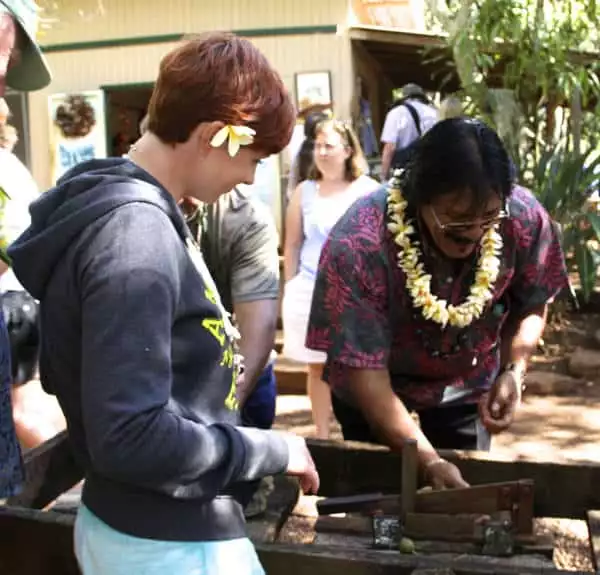
Our next stop is Kalaupapa National Park, on the Northern coast of the island of Moloka’i. The national park was established on December the 22nd of 1980 and is dedicated to preserving the memories and lessons of the past. The national park includes 2,000 acres of ocean and two small islands.
When we arrive at the park we find two paths, one is to Phallic Rock and the other is to the Kalaupapa Lookout.
Phallic Rock is a six foot tall natural rock formation that protrudes in a rather rude shape. It is believed that touching this rock, or staying at the site overnight, would increase fertility and therefore the rock has been visited by many Hawaiian women over the years. Although the rock is of natural formation it is said that the Hawaiians have made a few “enhancements.”
We take the path that leads to the lookout. When we emerge from the forest the view is truly breathtaking. We find ourselves at the top of the cliffs, looking out on the dramatic north coast of the island. These cliffs are the world’s highest sea cliffs, reaching heights of over 500 metres. Below us is the isolated Kalaupapa Peninsula, a ten square kilometre lava flow from the Kauhako Crater(3). This site is the location of the infamous Kalaupapa Leper Colony.
From 1866 to 1969 the people of Hawaii who were afflicted with Hansen’s disease, more commonly known as leprosy, were placed in forced isolation on the Kalaupapa peninsula on the island of Moloka’i. This settlement is still the home of several surviving patients.
The colony can be visited by official tour groups that will either hike or ride on mules down the five kilometre trail. The trail was hand carved by Manuel Farinha, a Portuguese immigrant, who hung from ropes draped over the cliffs. From top to bottom there are 26 switchbacks along the path. It looks like a wonderful hike however we will not have time to experience it today. Instead we relax at the lookout, taking in the spectacular view and, of course, taking plenty of photographs.
It is time to head back to the Safari Explorer as tonight we will be experiencing a traditional, Hawaiian pa’ina. The feast, often referred to as a luâ’au, is at the Moloka’i Museum and Cultural Centre.
The buffet offers all sorts of traditional foods and dishes that I have never heard of before. I try poi, a thick soup-like liquid that is made from boiled taro roots and water. Apparently taro is one of the most nutritious starches on the planet. I am not so sure about the taste of poi and so I move on to laulau, a traditional Hawaiian dish of meat wrapped in taro leaves. It is delicious!
A traditional Hawaiian dancer appears and performs a hula dance, before inviting us to join her and to learn some moves.
Day 7
We have an early breakfast on our last day on the Safari Explorer, as today we will be setting off for a full day excursion to Mo’€™oula Falls, a double-tiered, 76 metre high waterfall in the Halawa Valley.
Once again we are collected by the minibus and we set off. When we arrive we are greeted by Anakala Pilipo Solotorio, the last living descendent to be born and raised in Halawa who still resides there. He was chosen at the age of five to be the cultural practitioner for his family. This honour meant that he was given the responsibility of carrying on their traditions and cultural practices.
We set off on our three mile hike to the waterfall. First Anakala takes us through the family owned property and we learn the traditional honi greeting in which two people press their noses together and inhale at the same time, representing the exchange of ha (the breath of life) and mana (spiritual power between two people)(1). We continue along the trail to Mo’€™oula falls. From time to time Anakala stops and points out native species, ancient taro terraces, historical rock walls and worship sites.
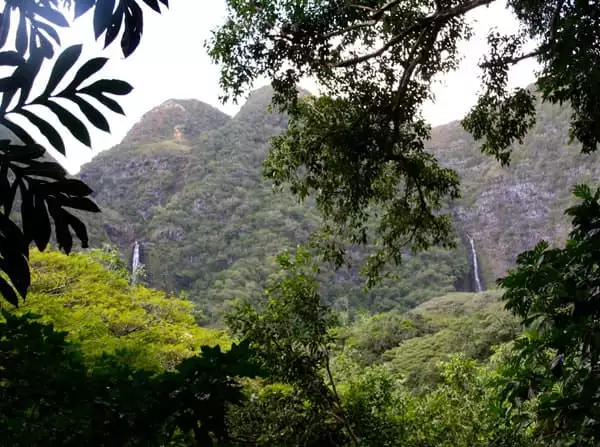
We stop by a very odd smelling tree and Anakala picks a fruit from the ground. He passes it along and tells us to smell it. I lift it up and immediately pass it on, it is the most foul smelling fruit that I could imagine. We are told that it is called noni and that it is supposed to cure all sorts of illnesses. The plant was originally brought to Hawaii by the ancient Polynesians in their canoes and was used for medicinal purposes and as a famine food. Our chef has joined us on the hike and tries to convince me that it doesn’€™t taste as bad as it smells as he tells me of stories where this fruit has healed people. I am adamant that I would have to be very, very sick before that fruit would be going anywhere near my mouth.
We continue and soon we hear the sound of water. We stop at a gap in the trees and from here we can see both Mo’oula Falls and Hipuapua Falls. They are beautiful! A short while later we arrive at the base of Mo’oula Falls. Anakala goes ahead of us, climbing up onto the rocks. He raises the conch shell that he has been carrying with him and blows into it, sending the sound across the valley. It is said that the sound of the conch is supposed to drive away evil spirits. Anakala begins to chant, asking permission for us to enter this sacred space. When he finishes the chant Anakala invites us to the pool at the base of the waterfall. We are told that we can swim and happily plunge into the pool, eager to cool off in the crystal waters. The water is much colder than I expected it to be but is very refreshing and we swim at the foot of the giant waterfall until it is time for lunch.
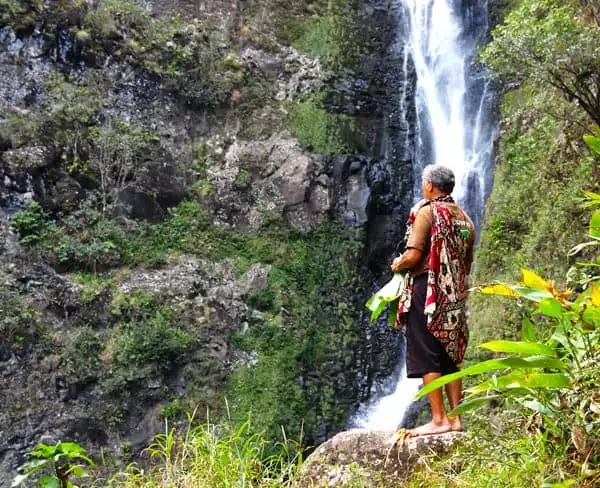
Chef Mike has brought picnic lunches for us and we climb onto the rocks to eat, as we dry off from our dip in the pool. I really don’t want to leave this beautiful island or the wonderful cruise but I cannot think of a better way to spend my last day here.
I really don’€™t want to leave this beautiful island or the wonderful cruise but I cannot think of a better way to spend my last day here.
After a very relaxing lunch it is time to return and we make our way back along the pathway. We thank Anakala for the wonderful experience and board the minibus for the last time.
It is time for our farewell dinner and we swap telephone numbers, addresses and e-mail addresses with our fellow passengers and members of the crew. It is strange to think that just one week ago all of these people were complete strangers.
We stay up late and reminisce about the wonderful week that we have had aboard the Safari Explorer, the amazing adventures and experiences that we have shared and we talk about where we will all be going on our next adventure.
It has been a wonderful week and tomorrow I will return to Maui where I will spend New Year’s Eve before continuing on to Oahu. As I drift off to sleep I begin to dream of the amazing experiences that I couldn’t even have imagined only seven days ago. I dream of diving with manta rays, of Pele, the goddess of fire, of paddle boarding at Shark’s Fin Cove and swimming in the cool water under the cascading falls of Mo’oula.
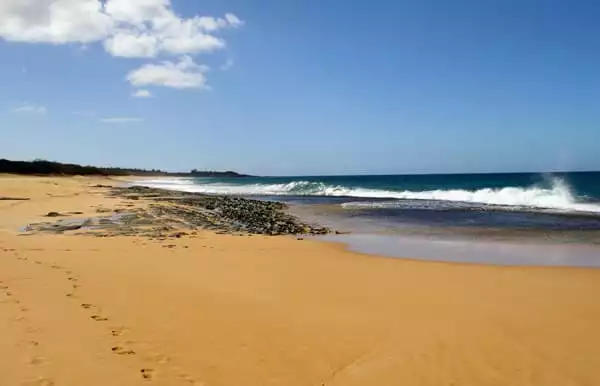
Comments will be moderated and will appear after they have been approved.